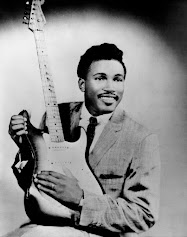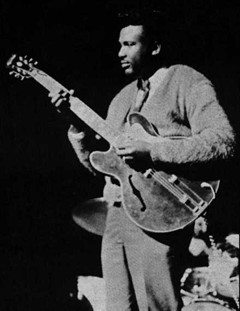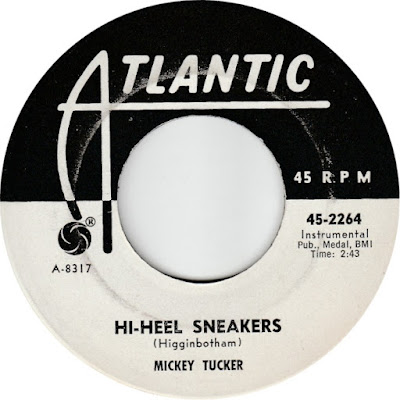Otis Rush Jr. (April 29, 1934 – September 29, 2018) was an American blues guitarist and singer-songwriter. His distinctive guitar style featured a slow-burning sound and long bent notes. With qualities similar to the styles of other 1950s artists Magic Sam and Buddy Guy, his sound became known as West Side Chicago blues and was an influence on many musicians, including Michael Bloomfield, Peter Green and Eric Clapton.
Rush was left-handed and played as such; however, his guitars were strung with the low E string at the bottom, upside-down from typical guitarists. He often played with the little finger of his pick hand curled under the low E for positioning. It is widely believed that this contributed to his distinctive sound. He had a wide-ranging, powerful tenor voice.
Rush was born near Philadelphia, Mississippi in 1934, the son of farmers Julia Campbell Boyd and Otis C. Rush,. He was one of seven children and worked on a farm throughout his childhood. At the age of eight, Rush taught himself how to play guitar; he also sang in local church choirs. He moved to Chicago, Illinois, in 1948/49 and, after being inspired by Muddy Waters, made a name for himself playing in blues clubs on the South and West Side of the city. During this period he formed his own group, initially under the name Little Otis From 1956 to 1958, he recorded for the independent label Cobra Records and released eight singles, some featuring Ike Turner or Jody Williams on guitar.His first single, "I Can't Quit You Baby", in 1956 reached number 6 on the Billboard R&B chart. During his tenure with Cobra, he recorded some of his best-known songs, such as "Double Trouble" and "All Your Love (I Miss Loving)." Cobra Records went bankrupt in 1959, and Rush signed a recording contract with Chess Records in 1960. He recorded eight tracks for the label, four of which were released on two singles that year. Six tracks, including the two singles, were later included on the album Door to Door in 1969, a compilation also featuring Chess recordings by Albert King. Rush went into the studio for Duke Records in 1962, but only one single, "Homework" backed with "I Have to Laugh", was issued by the label. It was also released in Great Britain as Vocalion VP9260 in 1963.
In 1965, he recorded for Vanguard; these recordings are included on the label's compilation album Chicago/The Blues/Today! Vol. 2. Rush began playing in other cities in the United States and in Europe during the 1960s, notably with the American Folk Blues Festival. Unofficial recordings at this festival in 1967 and at the University of Chicago Folkfest in 1966 were later released together with recordings of Little Walter.
In 1969, his album Mourning in the Morning was released by Cotillion Records. Recorded at the FAME Studios in Muscle Shoals, Alabama, the album was produced by Michael Bloomfield and Nick Gravenites (then of the band Electric Flag). The sound incorporated soul music and rock, a new direction for Rush.
In 1971, Rush recorded the album Right Place, Wrong Time in San Francisco for Capitol Records, but Capitol did not release it. The album was finally issued in 1976, when Rush purchased the master from Capitol and had it released by P-Vine Records in Japan. Bullfrog Records released it in the United States soon after. The album has since gained a reputation as one of his best works. He also released some albums for Delmark Records and for Sonet Records in Europe during the 1970s, but by the end of the decade he had stopped performing and recording. Rush was elected to the Blues Hall of Fame in 1984 and made a comeback in 1985 with a U.S. tour and the release of a live album, Tops, recorded at the San Francisco Blues Festival.
He released Ain't Enough Comin' In in 1994, his first studio album in 16 years. Any Place I'm Goin' followed in 1998, and he earned his first Grammy Award for Best Traditional Blues Album in 1999. Rush did not record a new studio album after 1998 but he continued to tour and perform until 2003, when he suffered a stroke. In 2002, he was featured on the Bo Diddley tribute album Hey Bo Diddley – A Tribute!, performing the song "I'm a Man", produced by Carla Olson. Rush's 2006 album Live...and in Concert from San Francisco, a live recording from 1999, was released by Blues Express Records. Video footage of the same show was released on the DVD Live Part 1 in 2003.
In June 2016, Rush made a rare appearance at the Chicago Blues Festival in Grant Park. Chicago Mayor Rahm Emanuel honoured Rush's appearance by declaring June 12 to be Otis Rush Day in Chicago. Due to his ongoing health problems Rush was unable to play, but was present with his family. The Jazz Foundation of America honored Rush with a Lifetime Achievement Award on April 20, 2018 "for a lifetime of genius and leaving an indelible mark in the world of blues and the universal language of music."
Rush died on September 29, 2018, from complications of a stroke he suffered in 2003.
(Edited
from Wikipedia)









































.jpg)





.jpg)



